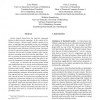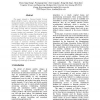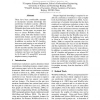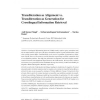797 search results - page 95 / 160 » The Entity Name System: Enabling the web of entities |
SRDS
2006
IEEE
14 years 3 months ago
2006
IEEE
Failure models characterise the expected component failures in fault-tolerant computing. In the context of distributed systems, a failure model usually consists of two parts: a fu...
WWW
2004
ACM
14 years 9 months ago
2004
ACM
This paper presents a Service-Oriented Process Model (SOM) to build a web-services based process management system, called MIDAS that would support distributed Design and Manufact...
ASWC
2008
Springer
13 years 11 months ago
2008
Springer
Both semantic web applications and individuals are in need of knowledge infrastructures that can be used in dynamic and distributed environments where different autonomous entities...
EMNLP
2009
13 years 6 months ago
2009
There have been considerable attempts to incorporate semantic knowledge into coreference resolution systems: different knowledge sources such as WordNet and Wikipedia have been us...
TAL
2010
Springer
13 years 3 months ago
2010
Springer
Crosslingual Information Retrieval (CLIR) usually requires query translation and, due to named entities in the case of IR, query translation requires a good transliteration system ...




